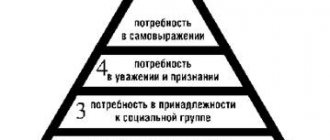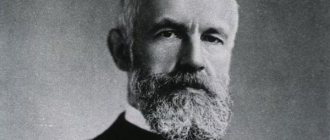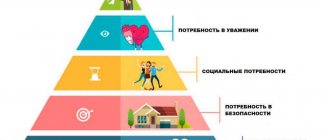This article was developed under the heading: Psychology. Section: Philosophy.
Every person, while studying at school, has heard more than once about human needs (basic needs, primary, secondary). Moreover, everyone knows Maslow’s theory of classification of needs. Therefore, we all know that every person needs food, water, shelter, and socialization to exist. But what is a need? How is the concept of “need” viewed in psychology? Why are such needs unique to humans? What theories of needs groups exist? Let's understand this basic concept of psychology and humanities together.
Human needs are the subject of research in various sciences and fields of activity.
What are needs
The term “need” is studied by many sciences, including psychology, social science, and philosophy. Therefore, interpretations can differ dramatically.
As a general rule, a need is a person’s need for something (things, objects, people, socialization processes), without which a person does not feel comfort, security and stability. In simple words, it is a person’s need for something.
According to another approach, need is an internal psychological and functional feeling of a person, which is expressed in the lack of any objects or objects, status, which change in contrast to the content of each specific person and the corresponding situation.
It is important to note that the term itself is characteristic not only of people, but also of representatives of the animal world. They also have a need for something - food, water, safety. However, humans are distinguished by the presence of spiritual and social aspirations, which, as such, are absent in animals.
Main features
In our lives there are different categories of social and psychological nature. And “need” is one of those terms. But what distinguishes it from other concepts that at first glance seem quite similar to anyone. Let's look at the main signs:
- They are constantly changing. This is due not only to the fact that in the course of life a person has different priorities, but also to the fact that needs depend on the character of a person, his worldview, life principles and values;
- They are dynamic. This means that they can be improved in the process of developing a person’s personality;
- They depend on the kind of life a person leads. What does it mean? Firstly, each personality is formed in the process of socialization. This means that a person and his needs depend on his environment, interests, and activities. Secondly, the acquired profession and skills also modify the aspirations of the individual;
- Possibility of recourse. In this case, a person may return to previous stages if primary needs are not adequately satisfied.
The hierarchy of needs itself (pyramid of needs) characterizes the stages of personality development.
What needs does a person have?
Man is one of the representatives of the animal world, with instincts and needs inherent in other species. At the same time, we have higher intelligence, feelings, and strong-willed qualities. This combination causes the presence of needs at two levels: basic and additional (primary and secondary).
Basic Needs
This group is vital for humans as a biological species. Basic needs are divided into two groups.
| Physiological | Existential |
| Breathing, nutrition, thirst, sleep, rest, procreation, housing. | Comfort, social and legal security, availability of employment, etc. |
Physiological basic needs must be satisfied first, since without them existence itself is impossible. The listed things and phenomena have been inherent in man since primitive times.
A person tries to make the process of satisfying basic needs more comfortable. If at the initial stage of the development of the human race animal skins served as clothing, today a whole industry is working to clothe us.
Basic needs can change with age in favor of the predominance of some over others. Sleep, for example, is more important for young children and older people, but in our youth we are able to get by with minimal hours of rest and still feel alert. Sex, as a primary need, can also, for a number of reasons, lose priority with age, but in adolescence it is a priority.
Questions often arise about security as a necessity for existence. Man has always experienced danger from phenomena in the surrounding world or from other people. A tsunami, a collapse of glaciers, an attack by wild animals or other tribes - all this forced a person to defend himself or run away. Over time, entire institutions were formed that were supposed to protect the individual from external incursions (army, police, Ministry of Emergency Situations). That is why safety is a primary need; we must understand that our lives and property are protected and protected.
The needs of existence (existence) appear as an individual grows up and determines his place in society.
Secondary needs
If a group of primary needs is necessary for survival and is laid down at the genetic level, then secondary needs determine a certain level of a person’s quality of life and come and are transformed with life experience.
Among the secondary needs in theory, the following are identified:
- Spiritual
. These include the need to obtain new knowledge about the world, the search for the meaning of life and one’s place in it, the development of creative abilities, and the desire for harmony. - Social
– love, friendship, interaction with other people, feeling part of society, a separate social group (class, work team, family). - Prestigious
. We are talking about the need for recognition of our successes, worthy self-esteem, respect from other members of the communities in which we belong.
Thus, primary needs are innate and determined by physiology, while secondary needs are psychological in nature and develop throughout life.
Meaning in human life
So, we have figured out what human needs are. But what is their significance in our lives? Let's figure it out.
Firstly, needs personify the personality itself. Therefore, their diversity allows us to say that the personality is versatile.
Secondly, needs influence the effectiveness of human activity. Psychology notes that they must be satisfied in the process of human activity. Therefore, when the concentration of the force of need is in the range of the “golden mean” (average strength), then human activity is most effective. When it is at a weak or strong level of so-called strength, then the work becomes ineffective.
Example. If a person has a need to realize himself as a leader, boss or adept in a specific field. But at the same time, he has been working for many years as a low-level employee, this is fraught with the following consequences. Firstly, he will not be satisfied with his work and life. Secondly, he will be deeply unhappy and aggressive towards others and himself. Thirdly, he develops a dislike for what is happening, cynicism. In general, such a person ceases to be healthy, since he cannot realize himself.
Human needs are satisfied in the process of his activities
Individual and community needs
Society consists of individuals who have their own biological characteristics - health status, characteristics of physiological processes in the body, differences in the structure and functioning of the nervous system, which determine the natural inclinations of a person. Based on natural inclinations, the abilities that a person realizes in his life are formed. The formation of a person’s needs is influenced by both his natural individual traits and the influence of the social environment.
In different eras, society had a need to use various natural inclinations and abilities of people. Thus, under the conditions of a caste system, abilities not related to the occupation prescribed for a given caste seemed unnecessary. For example, a person born in the merchant caste had the right to engage only in trade, in the laundry caste - only in laundry, etc.
One of the main trends in the development of relations between man and society is the individualization of the individual. Economic development and increasingly complex production processes required increasingly qualified, competent and independent workers. Currently, this leads to the gradual formation of an individual style of production activity and an individual style of consumption interconnected with it. .
The mechanism of interaction between the individual and society is modified and rebuilt. This is reflected in the relationship between individual and social needs.
In human societies there have always been differences between the needs of individuals, groups of people and society as a whole. As already noted, special mechanisms have been developed to regulate relations between society and the individual—primarily morality and law. However, it is now necessary to clarify the nature of these relationships: what are the specific differences between individual and social needs and what unites them?
The mechanism of the relationship between individual and social needs is reflected in the following patterns.
1. In the simplest case, social needs are simply the sum of individual needs. They can be easily quantified by simple addition. So, if one family needs one apartment, then a thousand apartments will be required to accommodate a thousand families. If, for example, it turns out that one person uses the services of a hairdresser on average once every two months, then it is easy to calculate how many people will come to hairdressers in a city with a million population. Urban planning standards are based on this simple relationship, allowing one to assess the need of an individual city for shops, hospitals, schools, consumer services, etc.
2. In more complex cases, social needs go beyond individual needs and are not reduced to their sum. This pattern was understood by the creators of the contract theory of the state. Thomas Hobbes believed that the state is necessary for citizens, since it satisfies the needs that exist among the people as a whole - in managing society, defense, maintaining public order, etc. A number of services are generally of a purely social nature and cannot be individualized, aimed only at one individual person. These are the activities of the media, public organizations, education and healthcare systems, public transport, the army and law enforcement agencies. All of them satisfy social needs. Thus, society as a whole, groups and associations of people acquire needs of a special kind, which cannot be completely, without remainder, decomposed into individual needs. At the same time, by satisfying social needs, we also satisfy the individual needs of people included in a given social community. There is no “man in general” who is the monopoly bearer of social needs.
The difference between social and individual needs is manifested in the difference in the mechanisms of their awareness. Society or social groups are aware of their needs longer and more complexly than individuals. Often a social need is first recognized by a small group of people or a government agency that draws public attention to it and makes efforts to achieve its widespread awareness and satisfaction. In our time, we are in a state of gradual awareness of the need to solve the environmental problems of civilization or in space exploration; in Russia there are a number of acute social problems (the need for society to care for homeless children, regulate migration processes, etc.).
It seems to us that the same needs can have different meanings for society as a whole, for different groups of people and for an individual. Thus, the need for procreation and raising children is urgent for society as a whole - it is clear that without its satisfaction it will cease to exist. At the same time, for an individual person this need is not considered urgent - even complete renunciation of family and sexual relationships is quite compatible with life and is a mandatory requirement for monks of various church denominations. The need for work is also urgent for society, but there have always been individuals who were not involved in work and probably did not feel the need for it. Such differences in the significance of the same need for society and for the individual are associated, in particular, with the fact that individual individuals perform different functions in the social system.
3. Finally, social needs are considered as the needs of the majority of individuals. In this sense, the needs of people who are not part of this majority are antisocial. Thus, we can say that the system of values expressed in the commandments of the Old Testament and the needs corresponding to it is social. To counteract people who impede their satisfaction (committing, as they say, “antisocial” acts), mechanisms of moral and legal coercion arose.
Complex processes of interaction between personal, group and social needs change and evolve throughout history. Thus, anti-democratic regimes that place a low value on the human person usually neglect their individual needs. The needs of only elite groups of the population are met here at a high level. In more democratic societies, numerous firms and organizations arise that specialize in providing services to the general public, since promoting better satisfaction of the needs of the bulk of citizens is an important priority of government policy.
Individual human needs
An individual is a single person, a representative of the human race, with unique psychophysical characteristics. An individual, in fact, has both individual biological and social needs.
Individual biological needs primarily include the needs for food, clothing and protection of life and health. Each person, depending on his gender, age, mental and physical activity, national traditions, habits, body weight and size, health status and tastes, requires his own individual nutritional standards in terms of calories, content of nutrients and vitamins, taste and individual requirements for clothing according to its sizes, models and other consumer properties.
Complete and high-quality satisfaction of individual needs for food and clothing pursues the main goal - satisfying the main need of the individual - protecting his life and health.
Satisfaction of this main physiological need, in addition to food and clothing of the individual, directly depends on his healthy lifestyle, which presupposes a high sanitary and hygienic culture for everyone, abstinence from the consumption of tobacco, alcohol and drugs.
In our country, 70% of the population does not engage in physical education, and the prevalence of physical inactivity (reduced mobility of a person due to a decrease in the strength of his movements) among schoolchildren has reached 80%, more than 30% of the population are underweight and the same amount is overweight, as a result of improper and irrational nutrition.
The problem of smoking is becoming increasingly acute in the country. In recent years, the proportion of men under 40 who smoke has increased from 1/2 to 7/10. The number of teenagers smoking is rapidly increasing. Today, every tenth schoolchild is dependent on tobacco and has some signs of smoking-related diseases.
Drunkenness remains an acute problem in the country. The overall morbidity rate for people who abuse alcohol is 2 times higher than for people who do not drink alcohol. Alcohol abuse is the cause of more than 7/10 of all accidents. The number of people using drugs has increased significantly. Their average age is constantly decreasing. Currently, more than 3 million people use drugs, almost two thirds of them are young people under the age of 30, who make up the main group of HIV-infected people.
Individual social needs of a person include his spiritual, ethical and aesthetic needs, the need for self-expression and self-affirmation, and protection from criminal attacks on his life and property. Knowledge and mastery of universal human values of peace, friendship, goodness, justice and mutual assistance; possessing a sense of beauty and love for family and friends, for the small and large Motherland; high aspirations for selfless service to one’s people and all of humanity - all these are the natural needs of a spiritualized person.
To fulfill this great mission, the comprehensive and harmonious development of the individual, his healthy lifestyle, which presupposes an organic combination of high morality and sanitary and hygienic culture, are necessary. Human biological and social needs are interconnected, complement and enrich each other.
The need for work is both a biological and a social need of a person. Strong and exciting work strengthens a person’s health, prolongs his life, making it interesting, meaningful, elevating and confirming the working personality. Therefore, a growing person from his childhood is invisibly faced with the task of knowing himself, his abilities, developing them and using them effectively in his present and future life.
Human family needs
The family is the primary and basic biosocial unit of human society, which is a group of people united by love, marriage and blood ties.
A family is characterized by three main features: cohabitation of its members, the presence of their relationship and joint management of the household, and a common budget. Important functions of the family: love, giving birth and raising children, mutual assistance in life and everyday life, spiritual communication and unity. All these functions determine the interrelated physiological and social needs of the family.
The first and most important biological need of a person is the need to reproduce the human race, to give birth and raise children, which is also a social need of people, because by giving birth and raising children, a person achieves self-expression and self-affirmation among his close contemporaries and relatives. A son or daughter, each of them is the successor of the parents' line, the heir to the family values of their ancestors.
The family is based on peace, mutual understanding, friendship, harmony, respect for elders and the best national and family traditions. Spirituality and morality that reign in the family are given first place. As sociological studies have shown, the second place is firmly occupied by the family's financial wealth and its living conditions, which determines the possibilities and desires of parents to have a second child. At the birth of their first child, for most parents such conditions are not the main and determining ones.
Maximum satisfaction of all the needs of families and an increase in their material well-being contribute to an increase in the birth rate and growth in the total number of people, which is the main indicator of human development. In strengthening family ties and increasing the birth rate, great, and in some cases decisive, importance is given to the economic activities of family members, their households and the entire economy as a management system.
Social needs of people
The appearance of a person determines his social essence. The first social need of a person is his communication with people like him. All non-family communication between people and all their social needs, by nature and scope, can be divided into four levels:
1) team (groups of neighboring and friendly families, employees at work, students, colleagues in amateur and other activities);
2) region (residents of villages, districts, cities, regions and other administrative-territorial and natural-geographical areas);
3) country (citizens and the entire population of the state);
4) humanity (world community of people).
After family, the closest and most necessary communication for people occurs in a team in the process of joint work, joint arrangement of everyday life, other joint activities and recreation. Therefore, when asked what happiness is, people often say - it’s when you go to work from home with joy and return home with the same joy. Companionship and healthy friendly relations between employees and a favorable psychological climate in the work team have a great positive impact not only on the psychophysical state of people, but also, as a consequence, on the results of their work. Conversely, the absence of such relationships and such a climate leads to mental disorders, nervous and other diseases. It’s not without reason that they say that if you’re in a bad mood, everything will fall out of your hands.
At the regional level, the main social needs of people are education, cultural performances, amateur and social activities, and biological needs consist of organizing public catering, the need to treat diseases, and physical education and sports. Satisfaction of these needs is carried out through the creation and operation of schools, universities, libraries, cultural centers, theaters, hospitals, clinics, sports facilities and much more, which require large monetary and material resources obtained as a result of the economic activities of people and the work of enterprises producing the corresponding material goods.
At the country level, legislative support is provided for the biosocial, individual, family and collective needs of people. The problem of legal regulation and state guarantees for the implementation of these needs is being solved. For this purpose, state bodies governing various areas of material production and culture, education, health care, social protection, law enforcement and other bodies are created and function. And all of them are supported by taxes and fees from income from the economic activities of people and the work of enterprises. Consequently, at this level, the satisfaction of people’s social needs depends on the economy, on material resources and money.
The highest level of people's social needs is their communication at the interstate level. The need for this communication and interaction between people of different countries is growing due to the increasing need for a joint fight against international terrorism and the transformation of local wars into global wars, pollution of the natural environment and the predatory use of natural resources.
Chapter 6. Formation of needs
1. Formation of needs in the conditions of scientific and technological progress
Technology, according to Marx’s definition, is “the materialized power of knowledge.”93 From this definition it follows that immaterial knowledge, as well as the organs of the human body (legs, arms, head, etc.) are inalienable human powers, and, therefore, the technology does not have certainty.
The human mind, using natural materials, transforms them into tools of labor, into means of transport, into weapons for defense and wars of conquest, into medical instruments, into means of sports and entertainment. The history of human society and social progress is clearly visible in the progress of technology - from the stone ax to the modern computer and spaceships. They are the objective embodiment of technical progress.
Technology is, first of all, a means of human activity. As such, it is used to achieve the goals that individuals, groups of people, nations or states set for themselves, therefore, technology is not created for the sake of technology, it has always been, is and will be a means to achieve any goal. Without functioning as a means, technology ceases to be itself, turns into scrap metal, into garbage.
In the history of society, technology has played the role of a two-faced Janus. Depending on whose hands it is in, it can serve both to multiply good and spread evil: deepening the environmental crisis, strengthening the power of anti-people regimes, spreading diseases. Technology frees people from exhausting physical labor and, at the same time, creates unemployment; it represents high-speed means of transport and, at the same time, is fraught with increasingly disastrous transport disasters (for example, the disaster in the spring of 1998 of a passenger train in Germany, moving at a speed of 200 km per hour, in which about 200 people died and the consequence of which was the decision of the German government to limit the speed of trains to 100 km per hour). Technology promotes the assimilation of new areas of natural resources, but it also brings closer the hour of environmental catastrophe. The list of contradictory, mutually exclusive consequences of technological progress can be continued. They all emphasize the idea that technology can serve both humane and inhumane purposes. The mentioned two-facedness of technology gives rise to an ambiguous attitude towards technical progress throughout history.
Even in ancient civilization, there was an ambivalent attitude towards technology.
If Herodotus describes with joy and admiration such amazing creations of technical art as the Isthmus of Athos, the bridge over the Gellospont, the aqueduct on Samos, if Aeschylus in his “Prometheus” explains the fundamental human mission of technology, then Sophocles already gives reasonable proof of the dangerous nature of technology in the famous chorale from "Antigone". He talks about the terribleness of man, which led him to technology, about the monstrous destructive power that technology gave to man. Since man, with the invention of technology, has received an unexpected intellectual tool into his hands, he is at the crossroads between good and evil.94
Many ancient thinkers, for example Plato and Socrates, placed a contemplative moral and aesthetic attitude towards nature above practical technical thinking. They considered the inventors of tools to be individuals of low intelligence. Technicalism as a synonym for pragmatism did not dominate the minds of the ancient Greeks.
The authors of technical inventions themselves (for example, Archimedes) considered it necessary to explain that they were engaged in research not for practical needs, but for the sake of entertainment. And the mythological Prometheus - a symbol of the transformation of the world - was not a human being and, because of this, transferred technical creativity to the realm of divine gifts that man simply “finds.”
The modern era is full of pessimistic predictions about the consequences of scientific and technological progress. Thus, the XV World Congress of Philosophy (1973), dedicated to the problem of “man and technology,” expressed the polarity of philosophers’ views on this topic. Western philosophers, representing countries with advanced technologies, were critical of technology, noted its dehumanizing influence on people, and called Marx a technocrat for his statements about the leading role of technology in the structure of the productive forces.
The English sociologist Kliter predicted a future when computers and robots will displace humans from all spheres of life and will dance the cancan on the grave of the last person, reproaching him for how stupid he was by creating thinking machines.
On the other hand, philosophers from India, Pakistan, and Afghanistan saw the cause of all the disasters of the peoples of their countries in the insufficient development of technology.
A broader concept of technology compared to technology. It is determined on the basis of a systems approach and helps to clarify the place of man in the direct production process.
Technology is a production process, considered from the point of view of the active implementation of a target setting with the optimal use of labor tools (technical and human), scientific achievements, production management methods and product quality control.
Humanization of technological processes means nothing more than the transfer of a model of the functioning of the human body and human activity to technology. Another pole of the interaction between man and technology in technology is the technization of man, i.e. the transformation of human organs and acts of his activity, his intellectual potential into one of the means (factors), into an instrument for achieving a technical goal. This is undoubtedly a dehumanizing sign of technology, since it sharply reduces the possibilities of a person’s self-realization, his spiritual and moral qualities, that is, everything that fits the capacious definition of personality.
By creating material values for society, a person depreciates, turning into a simple function of a technological process.
There are two ways to eliminate the dehumanizing feature of the technological process mentioned here. The first, compensating method. It consists of compensating for technical alienation in the production process with a good salary and creating conditions for the comprehensive development of the individual outside of production. Man moves from a position of being in himself to a position of being for himself.
The second method is to humanize the technological process, to create such conditions in production so that in the technological process a person can realize his personal and civic qualities. This second method is more difficult, and it should be the subject of close attention to technical education and its humanization.
Let's try to formulate some philosophical approaches to solving this problem.
In various forms of human activity, different types of thinking, different levels of the human mind, inherent in these types of activity, predominate. Main levels: analytical mind, synthetic mind, dialectical mind.
“Technology is the culmination of the analytical mind, and computers are the highest example of the analytical mind in action. And the greater the progress of computer technology, the greater the danger of turning the analytical mind into the only way of thinking and technologizing the entire human mind” (D. George. USA).
The training of engineering personnel is based on the priority development of analytical thinking. This is an axiom of technical education. The danger of dehumanizing the engineer, of training an inhuman engineer, does not lie in denying this axiom. Dehumanization begins where the analytical mind is seen not only as prevalent, but also as the only way of thinking of a future specialist. When the analytical mind is not limited to the sphere of technology, but expands to all other spheres of human life: culture, spiritual and moral life of society.
To avoid this, from the first days of a student’s stay at a university, it is necessary to focus on overcoming a one-sided view of their future technical specialty. It is necessary for the future technical specialist to focus on mastering a whole complex of humanitarian knowledge, so that he develops himself, first of all, as a person, and then as an engineer. This is exactly how many technological universities in Western countries are oriented, devoting up to 50% of their teaching time to the study of humanities.
We must also take into account the fact that not all problems studied by the technical sciences are purely technological. These are also human problems. Therefore, the program of technical disciplines should include issues of the history of science and technology, social and cultural prerequisites for the development of a particular technical science, the place and significance of a particular science “on the map of knowledge.” It must be shown that the dominance of analytical reason historically leads to radical atomism, in which all parts are separate, independent, discursive.
Synthetic intelligence is a trait of the mind or a trait of an intelligent person that forces holistic thinking, a system or a universality. This type of mind that considers all the elements of a structure in their relationships within a system. Synthetic intelligence forms a model of universal unity.
The synthetic mind forms the universal human position of the future specialist. This is achieved by teaching the humanities: history, culture, political science, aesthetics, ethics, linguistics, sociology. The functional purpose of this series of disciplines is to form the image of an individual in society, the state, and to master the system of social communications.
The formation and development of synthetic thinking of future specialists fits well under the name of humanitarization of technical education. Of the listed disciplines of the named cycle, the following have the greatest opportunity for shaping the personality of a technical specialist: sociology, aesthetics, ethics, linguistics. But since all these disciplines form predominantly the behavioral (social) side of a specialist’s personality and do not delve into the activity (professional) essence of the individual, they cannot claim a priority role in the process of humanization of technical education. Dialectical reason cements the connection between the first two levels of thinking. It is that aspect of the mind that holds us back from feeling fully satisfied with the results of our analytical and synthetic achievements. This movement from one perspective to another, from one point of view to another, is a guarantee against one-sidedness and ossification. This is a flexibility of mind that encourages a change of methods, a pluralism of approaches, and a search for ways out of dead-end situations of technical creativity. This is the feeling that the analysis done should not be taken as the end of the search, and the synthesis is never complete.
Dialectical thinking - large-scale, strategic. Philosophy plays a primary role in solving this problem in the training of engineers. This is achieved in the organic unity of ideological and methodological preparation. A significant role in this matter could be played by the organization, together with technical departments, of business games, including the solution of environmental problems by future engineers.
In this light, it seems to me that the true, and not imaginary, humanization of technical education consists in nurturing in a future specialist the desire and ability to fully realize his active essence in all spheres of public life on the basis of high professional training.
So, what new needs does modern scientific and technological progress create, which of the old needs does it level out or modernize taking into account modernity? Considering the virtual nature of needs, their conservatism and selectivity, their selection by different people, we should immediately warn you: there is no unambiguous answer to the question posed. We are talking about a trend that attracts most people in accordance with the realities of new technical improvements, but does not cover all citizens without exception.
The most general need, formed by technological progress and taking hold of large sections of the population, is the need for comfort in the broad sense of the word: the comfort of home, everyday life, vehicles, communications and communications.
Special mention should be made about the reasonableness and conditions for the formation of comfort needs.
Firstly, about means of transport. The need for high-speed means of transportation can hardly be considered reasonable. This need is generated by owners of large capital who are looking for ways to invest this capital. Example: construction of a high-speed railway from St. Petersburg to Moscow. It is unlikely that this need (to get to St. Petersburg in 3 hours) will take hold of a large number of the population. It is much more convenient to travel to St. Petersburg for 7 hours: take the train in the evening and arrive in St. Petersburg in the morning. In addition, there are a number of other problems: environmental, economic, etc., which create a situation in which the construction of this road is inappropriate.
And in general, high-speed transport (trains, cars, planes) is more fraught with disasters and the severe consequences of these disasters. We cited the example of the high-speed passenger train disaster near Hannover in 1998, which killed 200 people and prompted a government order to limit railway speeds to 100 km/h.
Secondly, about new means of communication and communication: cell phones, the Internet. These means of communication are acceptable for a limited number of people, law enforcement agencies, trade, etc. In many other cases, the use of cell phones brings harm to society: killers, thieves, criminal communities. The press noted the dissatisfaction of people visiting theaters when some visitors to the performance talk on their cell phones during the performance.
All these innovations in providing comfort must undergo social and humanistic examination before being introduced into mass production. These innovations should not be imposed on the population through all channels of information; it is necessary to ensure absolutely free choice of these needs, to make them accessible to the mass consumer, and not to make them the exclusive privilege of wealthy people.
The next need, formed by technological progress: multidisciplinary orientation of specialists. Technical progress leads to obsolescence not only of equipment, but also of technical specialties: many of them die out when a specialist is still in his prime. We must focus on acquiring related specialties in order not to find ourselves without work and to withstand competition in the labor market. And finally, technical specialists must constantly reproduce the need for the humanization of technology, as discussed above. We must humanize and spiritualize technology so as not to turn into “cheerful” robots (McLuhan).
Psychological structure of needs
But what does the psychological structure of human need (both primary and secondary) look like? Human needs are divided into two structural elements. Let's look at them.
Item
In this case, the needs of the individual are considered as specific categories, things, objects of the material world. That is, in fact, a person always has an awareness of what will help him satisfy this or that need. Therefore, needs are satisfied by obtaining some objectively expressed results of human activity.
Reaction (discomfort)
When an individual's needs are not met, a person experiences discomfort. It's kind of stressful. Which is expressed in the fact that in the absence of the opportunity to satisfy the needs of the individual, a stressful situation arises, aggression, irritability and other characteristics.
Thus, the structure of needs is as follows. Firstly, this is something that can satisfy one or another desire. Secondly, this is what a person will experience if the need is not satisfied. That is, it is a kind of motivation, albeit based on negative feelings.
Formation of human needs
Taking into account the considered classification of needs, we can talk about the features of their formation. Basic physiological needs are innate, transmitted to us at the genetic level. A person lives with them until his death; without receiving them, he dies physically.
Such needs cannot be prohibited or imposed by force. Primary needs cannot be good or bad, pure or dirty. Only ways and methods of satisfying them can be considered unworthy. For example, a person uses a public space instead of a toilet.
Primary spiritual needs also appear with a person. The presence of love, close people, harmony, and self-realization in life are mandatory for his mental health. Of course, without the listed benefits, a person will not die, but he will be stuck in reflection and frustration for a long time.
Secondary needs are formed in an individual in several stages.
Infancy
All the physiological needs of the baby are provided by his parents. Since the child has contact with adults, social needs arise even before six months: he smiles, looks at rattles, identifies mother and father.
Earlier childhood
At about the age of 3 years, the baby develops an understanding of objects to satisfy needs - he realizes the need for toys, certain food, specific clothing. Cognitive needs grow, the child reads books, sculpts, draws, and actively explores the world.
Preschool period, primary school age
Children's social environment expands significantly. In addition to mothers and grandmothers, they have their own friends - children from kindergarten, class, yard or clubs where he begins to go. The need for communication, recognition, mutual assistance and understanding is formed.
Teenagers
At this age, the last physiological need is revealed - sexual. For the first time, such secondary needs as self-realization and self-improvement are formed. There is a sharp change and expansion of cognitive interests. A teenager strives to learn about those things and objects that he did not even think about in the early periods of his life.
On the basis of the formed sexual need, a need for a person of the opposite sex and romantic experiences appear. The need for communication is shifting towards peers and friends. Relatives fade into the background.
It is believed that by the end of adolescence, all the basic needs of a person have already been developed. Their further development occurs through changes in their content and methods of achievement.
Need Development
As already mentioned, the needs of the individual develop and are formed throughout life. Therefore, they go through certain stages of development. There are two of them:
- The first stage is directly related to the fact that in order to carry out any activity, a person develops an ideal or image. Further, this image becomes the hidden motive of human activity;
- The second stage is characterized by the fact that human need is strengthened, specified and fully formed. For example, initially a person may develop a desire to care. He will be aware of this need. Further, after it has been specified, the person will look for the subject of the need for care. For example, a person who can be taken care of, or a person who can take care of himself.
In fact, at the second stage, the so-called phases of needs are replaced. If in the first stage the object of need first arises. Then on the second everything happens exactly the opposite.
Need is...
It is not difficult to understand what needs are, since the answer is contained in the root of the word itself.
This is a requirement of the body (in a broad sense) of something, a need, a lack , which is felt in the form of psychological and physical discomfort.
For example, you want to eat: your stomach “whines”, your activity decreases, your blood pressure drops, irritation and nervousness set in. The longer you go without food, the worse your general condition becomes. But as soon as you have a full meal - satisfy the feeling of hunger, both your mood and well-being improve.
Thus, the need manifests itself at the level of physical sensations and emotions .
The resulting discomfort forces a person to look for a source with which he can relieve himself of need, which automatically brings pleasure.
And now you are heading to the refrigerator and looking for something tasty there, or going to the grocery store. Having had a nice meal, you relax, and you want to lie down on the couch and enjoy being full, and maybe even sleep. This is the next need - the previous one has been satisfied.
Then you will want something else, and more, and more. The human individual is constantly in a state of need, some desires are replaced by others . Actually, thanks to them, we are active and always strive for something: be it sleep, love or recognition.
Human needs are limitless, arise at birth and end after death.
Types of needs
In psychology, needs are often divided into groups. They are characterized and combined according to certain characteristics and factors. Let's look at each such group in more detail.
Basic human needs are divided into specific groups and types of needs
Biological needs
Such needs are often called “basic needs” or “human physical needs.” This means that such a set of desires and ideas is characteristic of absolutely every individual. In this case, it does not matter what character a person has or what values he has. Biological needs include:
- Food. Like any other living being, humans need food to continue to live and function;
- Water. Another necessity without which a person physically cannot function;
- Sleep - good rest for the body is the most important factor for life.
Such needs are also called natural needs. Moreover, there is a classification of lower and higher needs. Biological needs act as the lowest human needs.
Material needs
Many researchers also include biological needs as part of their material needs. Although this is not entirely the right approach. Of course, with the help of objects of the material world, natural needs can be satisfied. However, their satisfaction is not a material matter.
What is included in material needs? We can distinguish the following types:
- Purchasing things, equipment, furniture;
- Purchasing a house, real estate;
- The need for material wealth.
We can say that material needs are what are used to satisfy basic and higher levels of human needs.
Social needs
Communication and socialization are the engine of our progress and development. Therefore, almost from birth. the child has a strong need for interaction. For example, a small child under 3-4 years old is attached to his mother. That is, his development depends on his attachment to his mother and the satisfaction of his social needs.
The group of social needs includes the following elements:
Love
In communication
Friendship
Understanding
Support
In interaction
Thus, a group of social needs remains with a person throughout his life. For example, it is unlikely that at least one individual will be able to live in complete isolation and lack of communication.
Spiritual Needs
Human needs are also spiritual. What does it mean? Firstly, they are fundamental in nature. That is, they shape our personality and our worldview. Secondly, spiritual needs are related to how we perceive ourselves and the world around us. Simply put, the spiritual desires of our personality are associated with a sense of aesthetics and delight.
The structure of this group includes the following types of needs:
- Art;
- Faith;
- Career and Education;
- Self-realization.
Thus, we can say that they personify a person’s spiritual harmony with himself. That is, these are the desires that make a person happier.
The possibility of creative (spiritual) self-realization is necessary for the human personality
The main feature that determines the individual nature of needs
Thus, speaking about how the individual nature of needs manifests itself, it is necessary to note the direct connection of this nature with human consciousness. Needs determine direction and focus attention in a specific direction. On the other hand, man himself, as a highly developed being, is able to determine his needs and concentrate precisely on those things that determined his personal choice. Anyone whose value system is dominated by career growth will have a need for it. His consciousness will focus on actions to achieve promotion. Anyone who wants to move to another country will direct the focus of their attention to filling this need.
Additional types of needs
However, at the moment, other types of elements necessary for humans are also being identified. They are also called “secondary needs”. Because they are different for each person. Moreover, they may, in principle, not arise in an individual. Let's look at the main ones.
Need for movement
At its core, the need for movement is a type of biological need. In reality, without movement, the human body atrophies. It becomes unviable. Therefore, being without movement, a person is in danger of not being able to satisfy any of his desires.
Power as a need
Such a vital necessity is individual and specific. Therefore, it may not be present in all people. That is, the desire for power is a consequence of the established foundations of the individual.
Surely, you have thought more than once that someone you know definitely needs to be a leader. Or, on the contrary, they believed that the person was too cruel. Because he wants to dominate others. This is the very need for power. What it may include:
- Firstly, the desire to take a leading position in any relationship;
- Secondly, the desire to be a boss at work;
- Thirdly, a person’s high level of ambition;
- Fourthly, the use of methods of suppression in relation to others and an inflated sense of self-importance, as well as egocentrism;
- Fifthly, the possibility of reaching the stage of a tyrant in any social relationships.
Safety
This desire is also considered as the primary needs of a person. This need is inherent not only in humans, but also in animals. For example, for a normal life, every person must feel safe. That is, he must have a house, a roof over his head, as well as a certain income that will allow him to ensure his life.
There is a point of view in which the need for security is considered one of the fundamental ones. And this is indeed the correct position. That is, such a need is justified by physiological and instinctive reasons.
Achieving results
This life guide also depends on the individual. There are so-called people - conquerors, careerists. To feel complete and harmonious, they need to constantly achieve something. For example, set a goal to get a promotion at work and work hard towards it.
Career ambitions are also a type of human need
Need depending on another
It's more of an emotional whim than a physiological one. Despite the fact that it is based precisely on instincts.
So, a person is a living being who tends to think about the continuation of his kind. Therefore, due to the social characteristics of each individual, there is a need for close social and emotional connections.
Quite often in practice there are cases when a person feels inferior for several reasons. Firstly, he does not have a partner or a so-called love relationship. Secondly, he cannot realize his feelings (tenderness, kindness, care, love, etc.).
Liberty
What is included in this human need:
Freedom in relationships (the ability to freely choose your environment)
Spiritual freedom (freedom to choose profession, education, religion)
Freedom of movement (the ability to travel, change home)
A significant example of the need for freedom is the lockdown that occurred in March 2022. After being confined within four walls and unable to move freely, especially in Moscow, many experienced the first stages of depression. Moreover, specialist appointments have seen an influx of people suffering from disorders that have been made worse by isolation from the outside world.
Human needs and psychology
If needs exist, then they must be satisfied, and for this purpose purposeful actions must be taken. When a person has a need, he directs his strength to satisfy it. If you want to eat, you buy groceries and prepare some kind of dish. There is a desire to start a family - he is looking for a partner.
But, unfortunately, a person is not always able to satisfy his desires. Moreover, he cannot always understand what exactly he wants. But his peace of mind and happiness depend on this. Therefore, psychology pays a lot of attention to the study of people's needs. Psychologists have noticed several interesting features regarding needs and their satisfaction.
A person is not always aware of his needs. Sometimes people don't understand what they really want. This gives rise to mental suffering, which often turns into psychosomatic illnesses.
Desire and attraction
If a person does not realize what he is drawn to, psychologists use the term “attraction.” That is, he cannot achieve a comfortable state because he is tormented by a need that he does not realize and does not understand. When he begins to understand what he really needs, it is called desire. When desire arises, motivation arises.
Motives, goals, needs
What is motivation? This is a person's movement towards a goal. He has realized what he wants and strives for it; he has a motive. For example, a girl has a goal - losing weight. She begins to take certain actions: goes on a diet, runs in the morning, etc. She has a motive - so that guys pay more attention to her. Then she will begin to feel in demand, that is, she will realize her need.
Needs and emotions
Strong needs lead to strong emotions. If a person experiences strong irritation, it means that some of his needs are not satisfied, and he craves to get something. Therefore, it is important to understand what exactly you want: a good husband, fame, money, there is a desire to buy a big house or go to Paris. In principle, nothing is impossible. The main thing is to understand what you really want. Maybe just to get the attention of a nice neighbor.
Why is it important to share your needs and wants?
In order to answer this question, it is necessary to understand how needs differ from wants.
| Needs | Desires |
| 1. Needs are always constructive. Your needs always speak of importance, necessity for your normal functioning and life; 2. Needs are deep and fundamental; 3. They also allow you to find harmony with yourself. | 1. They are destructive. That is, desires can harm the development of personality and life. for example, drug addiction is a “want”, not a need; 2. Desires can be imposed by other people; 3. Desires can also be superficial. That is, they will not satisfy your true needs. |
Comparison of human needs and desires
Let's look at a specific example. So, you have an apartment in which you live. At the same time, you want to buy a dacha. But there is no money for it. This makes you irritated and angry with yourself. In this case, buying a summer house is a desire. On the contrary, if you have nowhere to live, then purchasing housing is a necessity.
So why is it important to differentiate between them? Firstly, this way you can properly distribute your energy and activities. Secondly, it will help you know yourself and other people better. Thirdly, it will allow you to set priorities correctly.
Characteristics of needs
Needs have a number of characteristics and are subject to certain laws:
- At birth, a person is characterized only by physiological needs, the rest develop later.
- The lower needs are characteristic of all people equally.
- The higher ones differ greatly from person to person and form an individual portrait of the individual.
- Satisfaction of lower needs opens the possibility for the formation of higher ones, but does not guarantee it.
- The higher the need, the less important it is for survival and the longer it may remain unsatisfied.
- The more a person is involved in various activities, the more complex his system of needs.
- Suppression has a negative impact on psychological and physiological well-being and deforms the personality.
- The occurrence and satisfaction are associated with various emotions.
- A person's focus is fixed on the subject of need and causes attention to flow in its direction.
More than 100 cool lessons, tests and exercises for brain development
Start developing
How to understand what you need and what you just want
In fact, we have already indicated in what ways this can be distinguished. But to make it easier for you, you can ask yourself the following questions:
- Can I live without this? For example, buying an expensive dress is not necessary. So, you can leave this desire and buy it when there are more material resources;
- What will this give me? Such a question helps explain to yourself the true nature of your obsession;
- Will I limit myself to this acquisition? It is important to understand here that your desires should not compete with your needs. Therefore, determine what is more priority for you.
Many people are not aware of their needs, so they often feel unhappy
What have we learned?
A need is a need for something, without which a person feels discomfort. The traditional classification divides needs into biological, social and spiritual. The theory of the American psychologist A. Maslow is also popular.
Previous
Social studiesSocial studies - what science studies and the definition of what it is, briefly about the concept (grade 5)
Next
Social scienceSocial norms and social rules of human behavior - what they are, why we need a brief introduction to the concept of social science
Theories about needs
In the theory of psychology, many classifications of needs have been developed and considered. They are called differently - theories about needs. At the moment, their meaning comes down to the division of needs on various grounds. Any of the theories may seem quite absurd to you, but all collected here are basic in the theory of psychology. Let's put aside prejudices and look at each objectively. Surely you have met at least one of them.
The most famous theory is Maslow's Pyramid
This theory is fundamental for many branches of knowledge. It is considered within the framework of medicine, psychology, and jurisprudence. This theory has become completely conformist and generally accepted in society. But what is it? Let's figure it out:
- Firstly, Maslow's pyramid is named after the researcher of the same name - Maslow;
- Secondly, the essence of this theory comes down to the fact that needs are divided into primary needs and secondary;
- Thirdly, it assumes that a person develops a special hierarchy of needs. Which act as a certain priority for a person.
Pyramid of needs according to the theory of A. Maslow
Primary Needs
According to Abraham Maslow's theory, primary needs are those that are associated with human physiology. These include the following needs:
- Food;
- Water;
- Reproduction of the genus (reproduction);
- Housing;
- Dream.
Secondary needs
Secondary needs include social, spiritual and other types. They mean that their satisfaction is possible only after the basic (primary) ones have been satisfied. What can they include:
- Communication;
- Power;
- Self-realization;
- Creation;
- Safety;
- Confession.
According to Maslow's theory, primary and secondary needs are distinguished
Alderfer's theory
The theory of this scientist comes from similar positions. However, it is more specific. She identifies three groups of possible human needs. Let's look at each of them.
Existence needs
It is logical that this type includes those desires that form the basis of human existence and life. So, these will include: sleep, food, water, safety. Simply put, these are the same biological needs, or primary ones according to Maslow’s theory
Need for communication
In simple words, this is the need for social connections (socialization) and communication. In addition, Alderfer also includes “high” (spiritual) needs in this group - self-realization, power, creativity and others.
Need for growth
Such a group is more associated with the optional, or additional aspirations of a person, which we examined earlier. For example, this group may include a person’s aspirations for self-development, self-training and education.
Fromm's theory
Erich Fromm is a famous psychologist. He devoted his life to the study of human personality. Therefore, in his works one can also find theories about human aspirations. They are divided into five main categories.
| Group | Content |
| Making connections | In this group of needs, Fromm implies that each person sees his goal as building social connections and contacts with other people. For example, friendship or building a family. |
| Overcoming | According to Fromm's theory, every person is initially an animal, and only then a person. Therefore, the basic need of people is to overcome their animal instincts. |
| Roots | Man is a social being. Consequently, everyone wants to feel part of the world, society, a small group. Everyone strives to leave behind a certain kind of “legacy”. |
| Identity | In other words, self-identification. That is, each person strives not to be like the others. In the process of growth and life, everyone tries to identify themselves among billions of other people. |
| Belief system | A person’s whole life is a need to build one’s own ideals, foundations and values. |
Erich Fromm's theory of human needs
As we see, Fromm proceeds more from a psychological point of view and the internal content of the individual. With other owls, Fromm identified the special psychological needs of humans.
McKelland's theory of acquired needs
David McCalland in the 20th century identified a special group of aspirations - acquired in the process of life. At the same time, he did not deny the validity of other existing theories. Thus, according to McKelland, the following types of acquired needs are distinguished:
- Need for power;
- In involvement;
- In success.
There are many psychological theories about needs
Focus
Selectivity of attention when perceiving reality is determined by the dominant need at a given time. For example, a hungry person will focus all his attention on those objects of the external world that are associated with food. A person who is obsessed with purchasing a new, more expensive car will see only fashionable foreign cars around. Therefore, such selectivity will also be one of the indicators indicating how the individual nature of human needs is manifested.









